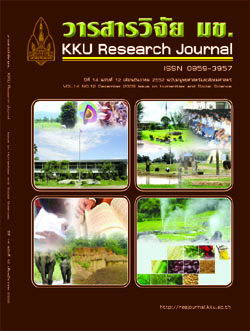Knowledge management in the office of Mahasarakram University Demonstration School
Main Article Content
Abstract
This study aimed to examine current conditions of knowledge management in the Office of Mahasarakram University Demonstration School, and to develop guidelines for developing a knowledge management model in the Office of Mahasarakram University Demonstration School. The target group was Mahasarakram University Demonstration School. Informants consisted of 30 teaching-line persons and 10 teaching-supporting-line persons. The instruments used for collecting data were a check-list, a structured-interview form, a participant observation form, and a questionnaire. The collected data were checked using the triangulation technique, and analyzed using frequency, percentage and content analysis. The study results were presented by means of interpretative, critical, and descriptive analyses. The results of the study are as follows:
1. For the current conditions of knowledge management in the Office of Mahasarakham University Demonstration School the following were found:
1.1 For the conditions of knowledge management in terms of learning, it was found that the organization had places, instruments, and information technology systems appropriate to learning at 100 percent and the least was that the organization had strategic plans, policies or others with connections in terms of learning culture promotion and had organization of training, meetings, seminars, academic discussions to be knowledge transference both inside and outside the organization, at 82 percent.
1.2 For the conditions of knowledge management in terms of knowledge collection, if was found that the summarization of knowledge generated from participation in training, seminars, discussions or being invited to be resource persons to make content, documents or reports or handbooks was the most, at 100 percent and the least was the making of summary documents, hand books for work performance, and reports to summarize operational outcomes with large quantity, at 75 percent.
1.3 For the conditions of knowledge management in terms of systematic storage, it was found that information technology from computer was used to assist everyone in the organization to communicate and connect to each other thoroughly both within the organization and with outside organization the most, at 91 percent and the least was having the e-Library system or websites for use in building knowledge systematically and appropriate to learning in the organization, and the information technology used in the organization generated an institutional memory which everyone in the organization could access, at 91 percent.
1.4 For the conditions of knowledge management in terms of knowledge sharing, it was found the technology was used to assist the personnel to coordinate, communicate and connect with data for utilization in the organization the most, at 100 percent and there were meetings for discussions and exchanging knowledge gained from meetings to transfer knowledge related to work performance the least, at 91 percent.
2. The guideline for developing the knowledge management model in the office of Mahasarakham University Demonstration School should be that knowledge management must begin from having accurate guidelines and strategies operating according to these 5 Stages : 1) determine clear vision, 2) determine strategies to operate, 3) develop the concrete form of learning, 4) enter the learning process, and 5) measure learning.
Article Details
References
Sallies, E., & Jones, G. 2002. Knowledge Managementin Education. London : Kogan Page.

